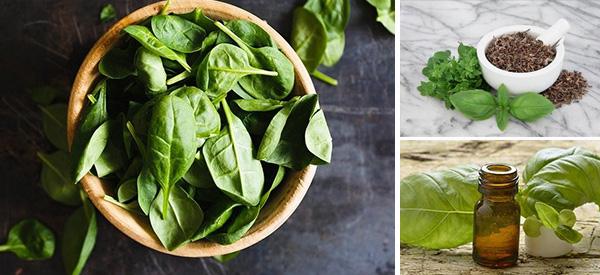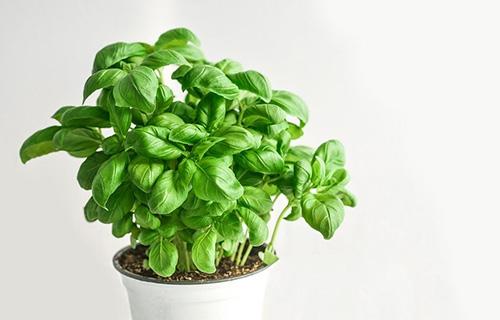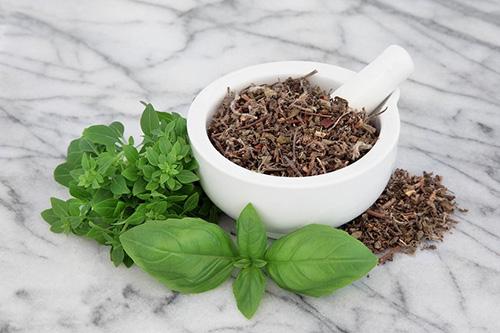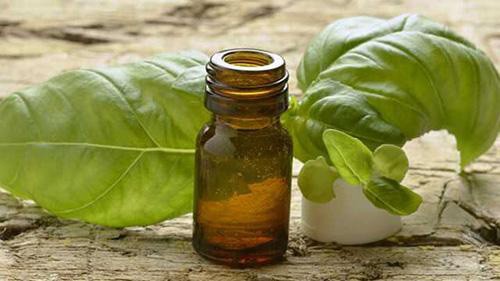
The Secret to Keep Basil Alive Indoors and How to Use It as a Medicine
Basil is a wonderful herb that can be a great accompaniment to your garden. Unfortunately, it doesn’t survive the first frost of the season, and you might find yourself needing it throughout the year. The good news is that basil can readily be grown indoors. Give it a try today!
Growing Basil Successfully Indoors
When you grow basil indoors, it has the same requirements as growing it outdoors: roughly 6 to 8 hours of direct sunlight each day. While direct sunlight is best, you can get portable grow lights or even put it under fluorescent lighting. It’ll need more light with fluorescent lighting. The recommendation is that for every 1 hour of direct sunlight, your plants need 2 hours of fluorescent light.

The good news is that most households keep their temperatures at a great level for growing basil. Just make sure you don’t put it right next to an air conditioner, where it could get too cold. As the temperatures drop outside, consider where you place your basil plant. Rather than leaving it adjacent to the window, move it to a nearby table in the evenings. To keep it from getting too warm or dried out, make sure you don’t place your basil plant too close to radiators, heat vents, or even dryer vents.

Like many plants, basil needs consistent watering. Keep a saucer under the plant and water gently until the water reaches the saucer below. Check your basil’s soil every few days and water if the soil starts to become dried out or if your plant is looking a little droopy. You can set up watering systems that are a little more complicated than top-down or traditional watering; putting the water in a dish and letting the plant wick it up as it needs water is one way to ensure it gets the watering it needs.
Harvest from your basil regularly to keep it growing and healthy. As you pinch off leaves, you can encourage the plant to get bushier, rather than taller, which will help keep it from taking up too much space in your house. Take leaves as you need them, but you should pick the youngest leaves from the top of the plant before picking older leaves. If you need a large amount of basil, just remember not to pick more than one-third of the plant, or it will not be able to maintain its growth and support the plant with photosynthesis.

Pests are uncommon with basil grown indoors but can still occur. Whiteflies are small insects that are detectable when you touch or go by the plant, flying up and around your basil. Small green insects around the stem of your plant indicate that you have an aphid problem. Head to your local nursery or hardware store and pick up an insecticidal soap, giving your plant a good washing to get rid of the pests. You can even find all organic soaps that are safe to use in your home and on the plant you’ll be eating or making medicine out of.
Related: How to Grow Basil Indoors
The Medicinal Uses of Basil
Now that you know how to grow sweet basil successfully, it’s important to know how you can use it. Basil leaves contain several compounds, such as eugenol, which may be helpful at settling an upset stomach and has been linked to killing off bacteria like Salmonella in the gut.
To make an essential oil with basil that can have antibacterial and antifungal properties, take a bunch of basil and blanch it. Make sure to cook the basil until it is quite soft and cool it in ice water. Make sure to drain the basil well and squeeze out any excess water. Blend the basil with 100 ml of refined oil and pass it through a sieve to ensure that all basil leave particles are removed.
Basil essential oil was shown to inhibit the growth of bacteria and fungal organisms. Topically applied with orange essential oils, basil oil may successfully treat acne with its antibacterial properties. If you don’t have orange essential oil on hand, you can still reap the benefits of basil for blemishes: simply boil a few leaves in a cup of water for approximately 10 minutes. Filter the leaves out and let the liquid cool, applying it to problem areas after it has cooled. This mixture should be made fresh each day.

You can consume basil in 100 milligram/kilogram dosages to improve vital measurements such as fasting blood sugar and cholesterol levels. While the exact mechanism is unknown, it is believed that the basil may suppress glucose release or stimulate a process known as glycogenesis.
If you have a headache, steep several basil leaves in hot water and then sip it like a tea. It is believed that the reason this helps is that it acts as a very low-grade muscle relaxer, which can make it may also help if you strain a muscle. You can also simply chew on a leaf to get more immediate relief if you can tolerate the more concentrated flavor of the basil.
Chew on fresh basil leaves if you have kidney issues or cramping associated with PMS. You can even try mincing basil leaves and mixing it with something sweet such as pineapple. The combination is especially effective for bloating. Mixing basil leaves with your fresh foods can also help decrease inflammation and may promote eye health due to the presence of vitamin A.
A relatively effective remedy for congestion is to boil eight fresh basil leaves with five cloves. Boil the mixture for 10 minutes and strain it. Sip the liquid as it cools and feel your sore throat slip away.
It’s important to note that unless you’re making a basil oil mixture and storing it away from heat, basil should generally be used fresh. When you boil it to consume, you’ll want to sip this “basil tea” as it cools rather than brewing it for later. You can use basil dried in dishes, which concentrates the vitamins, such as vitamin K. Consider breaking out your dehydrator to save a small portion of leaves.
Basil is a wonder herb and has been shown scientifically to decrease inflammation and improve gastrointestinal signs. Start growing it indoors and be prepared for health issues that crop up throughout the year.
You may also like:
 How To Make Tea Tree Oil To Treat Infections
How To Make Tea Tree Oil To Treat Infections
The US Army’s Forgotten Food Miracle (Video)
How To Make a Powerful Calendula Extract to Keep in Your Medicine Cabinet
If You See This Weed Growing In Your Yard, Don’t Pick It – Here’s Why
How to Make Cabbage Bandages to Treat Inflammation and Joint Pain

The is an invasive species in some areas. Best to keep it in a pot.
Not in our area… the winters kill it completely.
Happy to be a part of your group. I so enjoy all the information you share and have purchased your book which I have also been enjoying. I ask that you do not share my personal info with any one. Thank you
Hi Amy,
Thank you so much for your kind words. We really appreciate it.
God bless!
This is interesting to read, as I have G.I. issues. Hopefully it will also help in returning my appetite. Because of my G.I. issues I find myself not eating. Food repulses me.
Hi Janet,
Thank you so much for your comment.
I really hope the article will be of use to you.
I wish you the best health!
God bless!
Can the basil oil help with toe nail fungus? What kind of oil do you use? Olive oil?
Hi Linda,
Basil Oil is not known to help with toe nail fungus but there are a variety of oils you can use. The most common and the easiest to find is olive oil but you can also use: almond oil, apricot kernel oil, argan oil, blackseed oil, coconut oil, grapeseed oil, jojoba oil, peach kernel oil and rosehip oil.
God bless!
Calendula oil or salve might be more beneficial for toenail fungus
Hi Crystal,
Thank you for your comment. Agreed, calendula oil or salve is a better choice.
God bless!
Thank you! Basil is my favorite herb and I always have plenty growing. I really enjoyed this article!
Hi Melinda,
Thank you so much for your kind words. We really appreciate it.
God bless!
I am growing HOLY BASIL for the medicinal benefits, but I have noticed that it has no smell at all when all other basil’s have a strong distinct basil smell. I am afraid I recieved the wrong seeds. Do you know if it should smell like average basil?
Hi Charlayne,
Thank you so much for your comment.
The reports of holy basil’s smell and taste vary. Some claim it to be delicious, smelling of bubble gum. Others say it smells like lemon and mint, with leaves that produce a bitter but pleasant tea.
God bless!
Does white basil work as well as sweet basil?
Hi Melody,
Thank you so much for your comment.
Yes, white basil works the same!
God bless!
The tea you mention above — eight fresh basil leaves with five cloves, of what? Garlic?
Hi Shirley,
Thank you so much for your comment.
The cloves we were talking about is Syzygium aromaticum.
God bless!
Just received your book, easy for a beginner to understand.
Thank-you. I enjoy your e-mails as well.
Hi thanks for your help I have basil in my garden and use every day
[…] The Secret to Keep Basil Alive Indoors and How to Use It as a Medicine […]